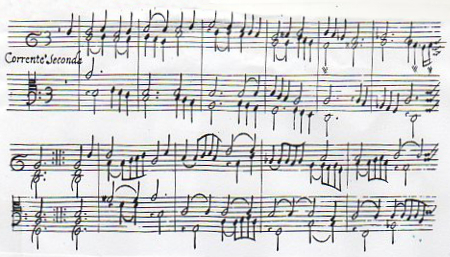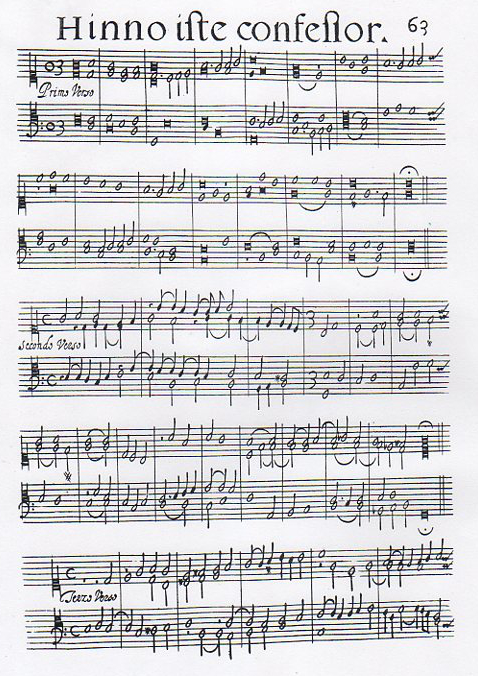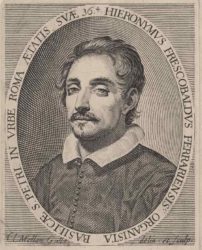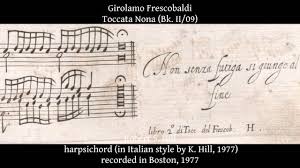15.1 Frescobaldi announced his second collection of toccatas as the exemplars of a “new manner,” a “nuova maniera.” He noted “the novelty of the artifice, with which they are framed and woven” (“la novità dell’artificio, con quale sono ordite, e tessute”), and that their performance demanded “grace, ease, variety of measure, and elegance” (“gratia, agevolezza, varieta di misura, e leggiadria”). The dedicatee to whom these observations were addressed was an amateur harpsichordist of professional caliber, and the bulk of the volume consists of genres appropriate to the harpsichord: toccatas, variations, canzonas, dances, and a madrigal intabulation. However, the collection also presents Girolamo’s first published works destined specifically for the organ: two pedal toccatas, two toccatas for the Elevation of the Host, and versets for vespers comprising four hymns and three Magnificat settings.
15.2 This opera omnia format is one example of the Neapolitan influence on Frescobaldi’s second toccata collection. The inclusion of an intabulation of Arcadelt’s madrigal “Ancidetemi pur,” set also by Mayone (1603) and Trabaci (1615) is not so much an imitation as the response to a challenge, but the presence of a toccata “of dissonances and suspensions” (“di durezze e ligature”) and the appearance of canzonas that open with chordal passages in triple meter unequivocally echo Neapolitan practices. Since Frescobaldi’s collection was issued twelve years after the last significant Neapolitan keyboard publication, however, the influence seems a case of conscious artistic choice rather than automatic imitation and expresses everywhere Frescobaldi’s own musical personality. The organ toccatas over pedal-points, for example (a north Italian device that first appeared in print in Annibale Padovano’s posthumous Toccate of 1604), evoke in their great washes of color not the intricacy of the Neapolitan Baroque but the as yet undecorated vastness of St. Peter’s. The cross-pollination of genres in the Frescobalda variations and the introduction of the Ciaccona and Passacagli from the guitar repertory are unparalleled in the Neapolitan collections.
15.3 The toccatas of the 1627 collection fall into three groups: harpsichord toccatas in a style developed from the toccatas of the 1615 collection, numbers I, II, VII, IX, X, and XI; the two pedal toccatas for organ, V and VI; the Elevation toccatas, III and IV, and the related Toccata VIII, “di durezze e ligature” (see Musical Examples 8-19). In the 1615 toccatas Frescobaldi had achieved musical unity in works comprising large primary sections and ambiguously defined small ones through free figuration and no metrical contrast; this balancing act he does not seem to have been inclined to repeat in 1627. The 1627 toccatas tend toward more clearly defined subsections marked by motivic consistency within and metric and textural contrast without. This development is perhaps least apparent in the opening sections of the 1627 toccatas, since they were already the most clearly delineated divisions of the 1615 ones. The openings continue to define the initial tonality through arpeggiated chords enlivened by imitation and to outline the effective range of the work, often in gestures of expansive sweep (Toccata II, mm. 4-7). The most adventurous of these openings is that of Toccata XI. Harmonically (to employ an anachronistic but useful terminology), it proceeds to a cadence not on a degree closely related to the finalis (e.g., I, IV, V, V of V) but on VI established as V of V of V. Frescobaldi’s constant sense of significant detail is evident in the preparation of this cadence as early as m. 5, and an increased capacity for large-scale harmonic planning is apparent in the delay of the cadence for sixteen measures after its preparation (Toccata XI, mm. 5, 14-15, 20-21). The same technique of reinterpreting harmonically a melodic arrival is employed as a transition from the cadence of the opening section in Toccatas I and II (Toccata I, mm. 14-15; Toccata II, mm. 15-17).
15.4 The closing passages of the 1627 toccatas are more clearly defined than those of the 1615 collection. Figuration, whether linear or imitative, is consistent over a longer span, and harmonic expectancy is increased by slowing the rate of harmonic change. What was a passing ripple on the surface of an earlier toccata is employed here with exaggerated logic to define the cadence:
Ex. 15.1: Toccata X, mm. 65-74

15.5 The most dramatic emphasis of the concluding section occurs in Toccata I, which shifts to a 12/8 proportion where the triplets gradually permeate the texture and are then pulled back to permit a dramatic rhythmic acceleration (Toccata I, mm. 57-63).
15.6 This increased definition is more apparent in the central area of the toccatas, above all in the insertion of sections in triple or compound meter (I, IX, X, XI), a feature that had previously appeared only rarely in the toccatas of the Neapolitans and never in those of Frescobaldi. The crisp rhythmic definition of these sections is one example of what is perceived as a “focused” texture, if we define focus as the consistent use of one or more elements of musical coherence such as sequential figuration, repeated rhythmic patterns, regular imitation, consecutive harmonic motion, and structural parallelism or repetition. The contrast between focused and unfocused sections is an important aspect of the new formal definition in the 1627 toccatas. Often this is expressed in abrupt juxtapositions of contrasting textures, but Frescobaldi’s skill at motivic manipulation also creates modulations of textures that seem to grow under the player’s fingers :
Ex. 15.2. Toccata II, mm. 23-43
15.7 The full range of effects in these toccatas is exploited in Toccata IX, to which its composer added the apt judgment, “Not without effort does one reach the end” (“Non senza fatiga si giunge al fine”).[1] Here the opening is not chordal but rather is an expansion of the opening triad through two and a half octaves (Toccata IX, mm. 1-4). The range widens further, until within two measures the functional boundaries are touched: the low E recurs at strategic points and is always emphasized by a change of register (mm. 9, 11, 23-24, 49-50, 55). The sections that follow are relatively short and are set off by frequent minim chords, with abrupt contrasts of textures and a variety of three-against-two rhythmic patterns, often linked by reinterpretations of cadences (mm. 12-13, 21-22, 26-27, 36-37). In the middle of the toccata Frescobaldi creates a rhythmic modulation rivalling those of his English predecessors (mm. 31-32).[2] Focused and unfocused passages are joined with abandon (mm. 51-55). Frescobaldi reserves his most dazzling rhythmic effects for the final cadence, an apotheosis of the preceding rhythmic clashes (mm. 65-66).
Ex. 15.3. Toccata IX, mm. 57-69

15.8 Such characteristic devices as the internal pedal-points and the grinding combinations of trills and passaggi embody the fancy in conception and extended logic in execution characteristic of Baroque art.
15.9 Toccatas V and VI are subtitled, “On the pedals for the organ, and without” (“Sopra i pedali per l’organo, e senza’). Despite this ambiguous designation, these carefully planned pedal points are indispensable in that they delimit the great blocks of sound, inflected by changing harmonies and modes and animated by constantly varied figuration, which make up these works. The pedal bass of Toccata V presents two rising fourths (G, C, F) and two falling fifths (A, D, G) linked by a mediant relationship, F-A. Toccata VI employs a cycle of fifths, F, C, G, D, A, which leads, again by a mediant, into the final C-F cadence. Both works thus display a harmonic outline that reaches a high point of intensity—in Toccata V the longest of the pedal-points, in VI an intensification of the longest pedal—from which it moves by a pivot chord to a clear cadence.
15.10 Although the figuration of the pedal toccatas is more obviously decorative in its relation to the underlying harmonic structure, which is not merely suggested, as in the harpsichord toccatas, but unequivocally present in every measure, its luxuriance is not random. In Toccata V virtually all of the figuration is derived from or stresses the interval of a fourth, contracted into a chromatic third above the penultimate pedal. In Toccata VI the upbeat scale pattern that begins in m. 6 is continued inexorably for nine measures, presented in alternation between the hands, in imitation, or in dialogue, and frequently encompassing those sweeps through the range of the instrument that characterize Frescobaldi at his most exuberant
Ex. 15. 4 Toccata VI, mm. 1-20

15.11 If these two works display the most dazzling and public aspects of Frescobaldi’s art, the three remaining toccatas of the 1627 collection, III, IV, and VIII, show him at his most private and, at times, his most enigmatic. Toccata III, the first of the Elevation toccatas, is written in the second tone, of which Diruta says “you will use it for playing at the elevation of the Most Holy Body, & Blood of Our Lord Jesus Christ, imitating in the playing the harsh and bitter torments of the Passion” (“ve ne servirete per sonar’ alla leuatione del Santissimo Corpo, & sangue de N. S. Giesu Christo, imitando con il sonare li duri & aspre tormenti della Passione”). Toccata IV, the other Elevation, is written not in tone four, Diruta’s alternate suggestion, but in tone ten, which is appropriately played on the principal with an octave or flute and “renders the harmony somewhat sad” (“rende l’armonia alquanto mesta”).[3]
15.12 The Elevation toccatas are puzzling to player and listener alike on first encounter. While their rhetoric is obviously high and passionate and the logic of isolated elements is perceptible, there is little initial feeling of overall structure or destination. Indeed, this sensation of timeless contemplation is one of the aims of the Elevation, the musical creation of a kind of eternal present. In fact, however, the underlying harmonic structures of these works are more direct even that those of the pedal toccatas: in Toccata III, mm. 1-13, D-A; 13-19, A-E; 20-33, (E)-E; 33-46, D-D; 46-66, D-D; in Toccata IV, mm. 1-24, A-D; 25-44, D-A; 45-58, D-A.
15.13 The next level in the hierarchy that begins with these clear sectional divisions is that of the rate of harmonic change within the sections, which in both toccatas is generally regulated by a steady half-note pulse. Beyond this rhythmic level we enter an area where the unexpected is more important than the sequential and the expected, or at any rate where the unexpected can be explained only after its appearance. For example, Toccata IV is permeated by anticipated functional downbeats recognized as such only when they begin to move. In mm. 8-10 alone this device occurs four times. The resolution of the alto is echoed an octave higher by an anticipated downbeat in the soprano that becomes a suspension, as does the alto, and moves downward against an imitative motif that is derived from the opening (as is the decorated F-sharp in the tenor of m. 8). The ambiguity of the voice-leading is compounded by the scale descent apparently crossing from the soprano to an anticipated downbeat in the alto, followed by another in the soprano (Ex. 15.2).
Ex. 15.5: Toccata IV, mm. 1-21

15.14 Both Elevation toccatas are remarkable for their extended unbroken sections, and it is instructive to examine the longest of these, the opening of Toccata IV, to understand how Frescobaldi achieves this continuity.
15.15 Although it would be impossible to transcribe the Elevations into four distinct and coherent voices, much of their internal logic is revealed when they are examined as impressionistic realizations of a four-voice ideal. In the beginning of Toccata IV all four voices are sounding by the second half of the first measure, but the entrance in m. 3 has nonetheless the force of a bass entry in a four-part exposition. Some of this remarkable extension is achieved by illogic, as in the constant preparation and subsequent sidestepping of full cadences either by deceptive cadences or by chromatic alteration (for example, the lowered C and F in the general A-major context of mm. 14-17). Rising scale figures are an easily perceived unifying device and are variously employed, ascending regularly through the chordal texture (mm. 11-13) or declaiming against a version of the figure in thirds (mm. 17-18). To conclude the first section of the toccata the upbeat rising figure is reversed to become a descent from a downbeat, and the remaining measures are built around falls from ever greater heights (mm. 2-3, 11-17, 22-24).
15.16 If Frescobaldi is a master of strategic delay in the Elevations, he is no less capable of strongly directed motion. This may be achieved by a simple acceleration of note-values or harmonic movement, by melodic and/or rhythmic sequence, or by something as simple as repetition of a note (see Toccata IV, mm. 14-16).
15.17 Perhaps the best example of this control is the concluding portion of Toccata IV. Its rhythmic patterns, especially the Lombard rhythm, are consistent over relatively long spans. The harmony changes regularly every quarter-note, frequently a chromatic inflection of a more basic change on the half note, and the bass is firmly marked. The logic of linear construction, which is not necessarily the logic of part-writing, is adamant and lends a peculiar urgency to the figural patterns derived from the previous sections of the toccata.
Ex. 15.6. Toccata IV, mm. 40-60

15.18 Toccata VIII “di durezze, e Ligature” is built on stepwise chromatic lines, enlivened by discreet syncopations (see Music Example 4). The ending especially demonstrates the propulsive force of a rising chromatic line, already evident in the finale of Fantasia II. (The low “E”s in mm. 27 and 31 show that the work was intended for a short-octave keyboard.)
Ex. 15.7. mm 25-45. Toccata VIII “di durezze, e Ligature”

15.19 The remaining contents of the 1627 Toccate are a heterogeneous assemblage. The six canzonas fit neatly into Frescobaldi’s continuing exploration of the genre. The first three and the last extend the development of the variation-canzona, a procedure most strikingly exemplified in the descending chromatic subject of Canzona III. Free figural writing in sectional contrapuntal works, which Girolamo began in the capriccios, is now integrated seamlessly into the texture, so that sections regularly begin with the energy of canzona-motives and dissolve into brilliant figuration. The repetition of the opening section of Canzona IV adopts a common Venetian practice, as does the return of opening material at the end of Canzona VI, but the triple meters of the last two canzonas and the chordal opening and refrain of Canzona V in O3/1 are imaginative developments of Neapolitan characteristics (Trabaci 1603, Capriccio sopra la fa sol la; London 30491: Canzon d’Ippolito, Canzon di Stella, Macque Capriccio re fa mi sol, Canzon de Rinaldo). Canzona V is in a succession of triple mensurations with interpolated C measures: 3/1 = three whole-notes; 3 six black quarters; O3 = three whole notes; ![]() 3 = three half-notes (without a transition in C); O3 and 3 as before. Canzona VI is entirely in triple meter and employs the same mensurations: O3,
3 = three half-notes (without a transition in C); O3 and 3 as before. Canzona VI is entirely in triple meter and employs the same mensurations: O3, ![]() 3, 3 (black), and O3/1.
3, 3 (black), and O3/1.
15.20 A growing interest in dance rhythms is apparent in the collection’s five gagliarde, six correnti, and variations on the “Aria detto Balletto” (More Palatino) and “Aria detta la Frescobalda.” Neither dance type is fully stylized. The gagliarde, notated in 3 (three halves) and O3 (three whole notes), consist of two or three sections beginning on a downbeat; their rhythmic concision recalls the Neapolitan ensemble galliard.[4] Each corrente (notated in O3 = 3/2, 3 = 6/4)contains three sections starting with an upbeat and marked by the 3/2-6/4 ambiguity usually associated with the French courante. The second corrente is provided with another feature later adopted by the French, a written-out figural variation or double.
Ex. 15.8. a) Corrente seconda b) Corrente 2.a alio modo


15.21 The combination of dance and variation procedures is carried a step further in the two variation-sets, which include dancelike sections. The Balletto employs a variety of triple mensurations: ![]() 3 (three halves), 3 (two dotted black halves),
3 (three halves), 3 (two dotted black halves), ![]() (six halves = two dotted wholes), 6/4. The dance-like sections are identified as Gagliarda (3 = three halves) and Corrente (3 = 6/4) in the Frescobalda, which is thus the first published variation-suite and presumably the model for Frescobaldi’s pupil J. J. Froberger’s amalgamation of the variation and the dance-suite in his Auf die Mayerin.
(six halves = two dotted wholes), 6/4. The dance-like sections are identified as Gagliarda (3 = three halves) and Corrente (3 = 6/4) in the Frescobalda, which is thus the first published variation-suite and presumably the model for Frescobaldi’s pupil J. J. Froberger’s amalgamation of the variation and the dance-suite in his Auf die Mayerin.
15.22 The organ-versets for vespers—hymn- and Magnificat-verses—are a new genre for Frescobaldi only in their appearance in print. Like any other seventeenth-century Italian organist, he must have improvised their equivalents every working day of his life. In his Choro et organo (Venice: Vincenti, 1614) Bernardo Bottazzi described the process:
If the Organist wishes to play on some Cantus firmus subject, such as a Kyrie, Sequence, Hymn, Gradual, Alleluia, or the like, he must take a part of that plainsong, & make the parts progress (as if playing, and one striving with another) imitating that part of the chant, on which he wishes to play, with imitations now above, & now below, so that the parts imitate the other parts, and not the cantus firmus; because such imitations of the cantus firmus are so often practised, & employed, that they can be made rarely or never, that they are not commonplace, and often heard: it is true nonetheless, that in Hymns, and in Sequences the imitation of the cantus firmus is greatly necessary; but concerning the other canti firmi one can observe the above order, making one part imitate the other.[5]
15.23 However, evidence has come to light suggesting that Frescobaldi approached this genre with unexpected seriousness. Claudio Annibaldi has identified Frescobaldi’s hand in the Vatican manuscript Chigi Q. IV. 19, which includes thirteen polyphonic hymn-verses in score.[6] The first seven verses are transcriptions of settings by Palestrina in three to six parts of odd-numbered strophes for alternatim performance with even-numbered verses in chant. Numbers 8-13 transcribe even-numbered verses in four parts from hymn-cycles by Tomás Luis de Victoria. Annibaldi hypothesizes that the verses were copied ca. 1624-25, and in any case are datable before Urban VIII’s altered text of the hymn Urbs beata Jerusalem, published in 1629. Frescobaldi not only transcribed the originals from part-books but even noted mistakes such as parallel fifths—sixteen times in the Palestrina cycle but only four in the Victoria. In his own hymn-versets Frescobaldi followed Palestrina in the number of verses, Victoria in the use of a four-voice texture.
15.24 In Toccate II Frescobaldi set four hymns: three versets of Lucis creator optime for Sundays (present in both Chigi manuscript cycles), three versets of Exultet caelum laudibus for Apostles (changed to Exultet orbis gaudiis in Urban VIII’s revised hymnarium, Palestrina only); four versets of Iste confessor for confessors (Victoria only); and four versets of Ave maris stella for the Virgin (both cycles). The Magnificats on the first and sixth tones have five versets, alternating with even-numbered chant verses, and the Magnificat on the second tone has six versets, presumably alternating with odd-numbered chant verses. The chant materials are treated as long-note cantus firmi in one or more voices, paraphrased, or divided up to provide subjects for imitative treatment or tripla variations. G.B. Fasolo in his Annuale of 1645 described the performance of hymns:
“With the left hand the two lower parts will be played, with the right hand the upper part, up an octave giving the beat to the choir” (“Con la mano sinistra soneranno le due parti rimesse, con la mano destra la parte si sopra, alla ottaua alta dandoli la misura del Choro”3).
15.25 In their clear sense of direction and eminently satisfying economy of means the versets recall the liturgical organ music of Cabezón.
Ex. 15.9. Iste confessor a) chant b) organ verset


15.26 Toccate II defines the currents of the past and the future most sharply in the intabulation and the bass variations respectively. Arcadelt’s “Ancidetemi pur” belongs to the most classic of his madrigal collections, his first book of four-part madrigals, which went through some forty-three editions between 1539 and 1654 (including one by Monteverdi in 1627). Ascanio Mayone’s Primo libro di diversi capricci of 1603 included an intabulation of “Ancidetemi pur.” Giovanni Maria Trabaci’s Ricercate of the same year presented an intabulation of Ferabosco’s “Io mi son giouinetto [!],” as did Mayone’s second book of 1609, where the work was set by Mayone, Scipione Stella, and Montella. In his second volume of 1615 Trabaci included an “Ancidetemi per l’arpa.” Nothing could be further from the Renaissance intabulation than Frescobaldi’s realization of this suave, chaste work with its clear AAB structure as a continuous, passionately declaimed keyboard toccata (see Silbiger 19961[7]):
Ex. 15.10. Ancidetemi pur: a) Arcadelt, Ancidetemi pur b) Frescobaldi


15.27 The inclusion of variations on the Ciaccona and Passacagli, by contrast, begins a process of creating large musical structures from common and unclearly-defined elements, as opposed to the radical reinterpretation of an existing work of art in the intabulation. The ciaccona was originally a lively dance, the passacaglia a ritornello, and both were developed in the musically marginal world of the guitar tablature. When Frescobaldi took up these patterns they were still evolving, although the ciaccona had settled on the major mode and had developed a typical rhythmic pattern in triple meter; the passacaglia could be cast either in major or minor. The short repeated phrases of both patterns had a potential for chains of continuous variations strikingly different from the articulated, closed structures of earlier variation-sets. If Frescobaldi’s madrigal-intabulation represents the last flowering of a dying tradition, his treatment of the ciaccona and passacaglia in the 1627 book is above all the preparation for the great Cento partite sopra passacagli in the 1637 Aggiunta to Toccate I, in whose favor both of the present sets were removed from the 1637 reprint of Toccate II. In both of the 1627 sets the identity of the two-measure pattern is rigidly maintained, figuration is conventional, and chromatic interest is rare. Although the guitar tablatures present both patterns in a variety of keys, Frescobaldi maintains the original tonality throughout each set.
Ex. 15.11. Passacagli

15.28 The central achievement of this volume is its repertory of toccatas, which attain an unprecedented grandeur, richness, and expressiveness of declamation, now channeled and organized by clear and yet subtle structural principles. Equally striking in the dances and organ-versets of the collection is the composer’s command of epigrammatic statement. These two principles—grandiose rhetoric and the minimum of conciseness—reach out in oppposite directions, finally to meet in the Fiori musicali.
FOOTNOTES


